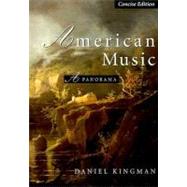
| AUTHOR'S GUIDE TO THE CONCISE EDITION | xi | ||||
| PART ONE. Folk and Ethnic Musics | 3 | (74) | |||
|
3 | (17) | |||
|
3 | (2) | |||
|
5 | (1) | |||
|
6 | (1) | |||
|
7 | (2) | |||
|
9 | (3) | |||
|
12 | (8) | |||
|
20 | (20) | |||
|
20 | (1) | |||
|
21 | (6) | |||
|
27 | (13) | |||
|
40 | (13) | |||
|
41 | (5) | |||
|
46 | (1) | |||
|
47 | (6) | |||
|
53 | (24) | |||
|
53 | (3) | |||
|
56 | (11) | |||
|
67 | (10) | |||
| PART TWO. Three Prodigious Offspring of the Rural South | 77 | (62) | |||
|
77 | (23) | |||
|
77 | (4) | |||
|
81 | (3) | |||
|
84 | (3) | |||
|
87 | (1) | |||
|
88 | (1) | |||
|
89 | (4) | |||
|
93 | (7) | |||
|
100 | (14) | |||
|
100 | (2) | |||
|
102 | (2) | |||
|
104 | (1) | |||
|
105 | (1) | |||
|
106 | (3) | |||
|
109 | (1) | |||
|
110 | (4) | |||
|
114 | (25) | |||
|
114 | (3) | |||
|
117 | (5) | |||
|
122 | (17) | |||
| PART THREE. Popular Sacred Music | 139 | (42) | |||
|
139 | (22) | |||
|
139 | (3) | |||
|
142 | (6) | |||
|
148 | (8) | |||
|
156 | (5) | |||
|
161 | (20) | |||
|
161 | (2) | |||
|
163 | (3) | |||
|
166 | (15) | |||
| PART FOUR. Popular Secular Music | 181 | (62) | |||
|
181 | (13) | |||
|
181 | (3) | |||
|
184 | (2) | |||
|
186 | (3) | |||
|
189 | (5) | |||
|
194 | (23) | |||
|
194 | (6) | |||
|
200 | (3) | |||
|
203 | (7) | |||
|
210 | (7) | |||
|
217 | (26) | |||
|
217 | (7) | |||
|
224 | (6) | |||
|
230 | (4) | |||
|
234 | (1) | |||
|
235 | (8) | |||
| PART FIVE. Jazz and Its Forerunners | 243 | (44) | |||
|
243 | (18) | |||
|
243 | (3) | |||
|
246 | (4) | |||
|
250 | (3) | |||
|
253 | (1) | |||
|
254 | (7) | |||
|
261 | (26) | |||
|
261 | (2) | |||
|
263 | (4) | |||
|
267 | (4) | |||
|
271 | (6) | |||
|
277 | (10) | |||
| PART SIX. Classical Music | 287 | (106) | |||
|
287 | (21) | |||
|
288 | (1) | |||
|
289 | (5) | |||
|
294 | (2) | |||
|
296 | (2) | |||
|
298 | (2) | |||
|
300 | (8) | |||
|
308 | (21) | |||
|
308 | (4) | |||
|
312 | (3) | |||
|
315 | (3) | |||
|
318 | (3) | |||
|
321 | (8) | |||
|
329 | (23) | |||
|
329 | (10) | |||
|
339 | (3) | |||
|
342 | (1) | |||
|
343 | (3) | |||
|
346 | (6) | |||
|
352 | (16) | |||
|
352 | (3) | |||
|
355 | (4) | |||
|
359 | (2) | |||
|
361 | (7) | |||
|
368 | (12) | |||
|
369 | (4) | |||
|
373 | (2) | |||
|
375 | (5) | |||
|
380 | (13) | |||
|
380 | (1) | |||
|
380 | (5) | |||
|
385 | (8) | |||
| PART SEVEN. Regionalism and Diversity | 393 | (16) | |||
|
393 | (16) | |||
|
393 | (5) | |||
|
398 | (3) | |||
|
401 | (8) | |||
| INDEX | 409 |
The New copy of this book will include any supplemental materials advertised. Please check the title of the book to determine if it should include any access cards, study guides, lab manuals, CDs, etc.
The Used, Rental and eBook copies of this book are not guaranteed to include any supplemental materials. Typically, only the book itself is included. This is true even if the title states it includes any access cards, study guides, lab manuals, CDs, etc.